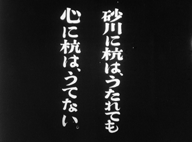The People of Sunagawa
(“Sunagawa no hitobito: Kichi hantai toso no kiroku”) 1955 / B&W / 16mm / 27 min
1955 / B&W / 16mm / 27 min
Photography: Matsuda Tadahiko, Sato Tadashi
Editing: Kamei Fumio, Numasawa Isezo
Sound: Okazaki Michio
Producer: Ono Tadashi
Production Companies: Japan Documentary Film, Hokusei Shoji
Source: Japan Document Film
This is the first film from Kamei’s own production company, Japan Document Film (which appears in the closing credits as Japan Documentary Film). The struggle began when then-Prime Minister Hatoyama’s cabinet promised to allow the US to expand Tachikawa Air Base, and tried to use force to make good on the promise. Sunagawa town was a peaceful town in Tokyo’s Kitatama County. Beautiful streams ran through the land, and the inhabitants made their living raising mulberry seedlings. But the inhabitants were constantly bothered by the earsplitting roars of American jets taking off from the base at Tachikawa. The surveying team announced that land was to be requisitioned for the base expansion, and farmers opposed to having the land they had inherited from their ancestors made into an American base organized the town to rise up in opposition. The second survey was conducted on August 24, and the third survey by force on September 13. This time, local residents fought with 1760 police from the early morning. In the afternoon a large number of workers arrived. Picketers formed an offensive scrum to oppose the police, and severe injuries were sustained on both sides. The next day, all of the police arrived wearing metal helmets. They broke through the picket line and forced their way onto the fields with the surveying crew, and the surveying crew began staking survey markers. In the film, the title “They can pound stakes into Sunagawa, but they can’t pound stakes into our hearts” suggests the long fight to come. On the 17th, the National Conference for Strategies against Military Bases held a press conference and announced a new level of conflict as the fight shifted from a local to a national scale. At the end of the film, the “solidarity” battleflag fills the screen.
